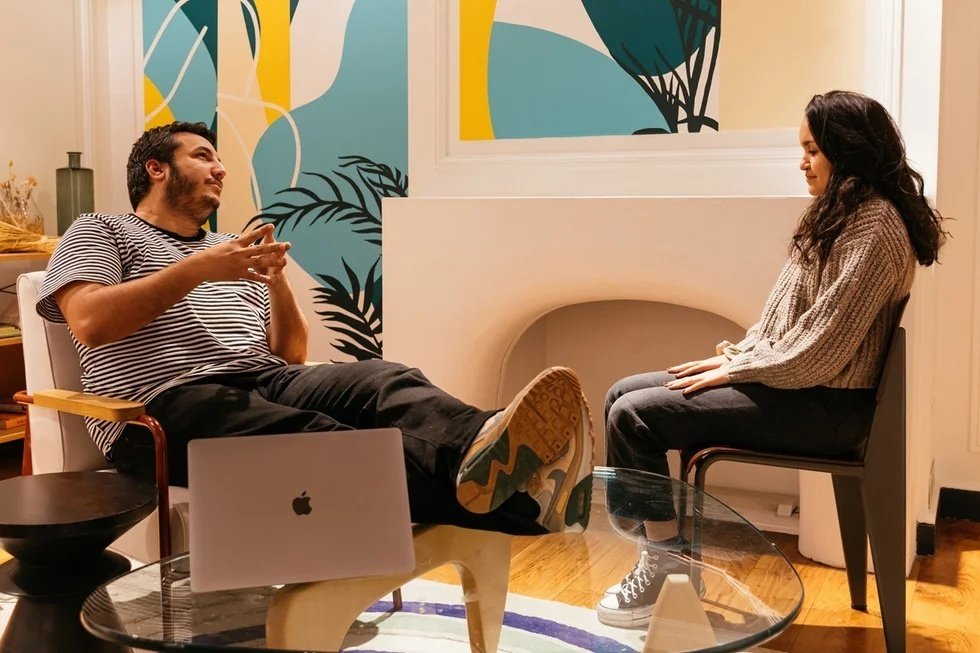The invisible interview partner: the power of understanding your attachment style
Jul 03, 2023
7 mins


Freelance journalist and writer
As mental health awareness continues to rise around us, you’ve probably already heard about the concept of attachment styles. We can see our attachment styles everywhere. They subconsciously define how we relate to others, they influence how we process and express emotions, and they affect how we approach most situations, both personal and professional.
All things considered, our attachment styles can certainly have a significant impact on how we present ourselves during job interviews. To explore the link between our attachment styles and their manifestation in our performance as job hunters, we spoke with Mariela de la Mora, Business and Leadership Coach, and Elizabeth Grace Saunders, Time Management Coach and Founder of Real Life E. With their tips and guidance, you’ll not only find out how to address your attachment style, but you’ll also discover how you can hone it to your advantage to become a better candidate and land that dream job you’ve been eyeing.
What are attachment styles, really?
Let’s start by breaking down the concept of attachment styles itself. What are attachment styles and how can they present themself? “An attachment style is a pattern in which we relate to other people,” explains Saunders. “It’s what you default to when it comes to connecting with others, especially in situations in which you feel emotionally vulnerable,” adds Mariela de la Mora. “Our attachment styles show up everywhere but they tend to surface the most in our intimate relationships, i.e. romantic ones, close friendships, and family ties. Though they can present themselves in the job interview process as well,” explains de la Mora.
Based on the original attachment theory of British psychoanalyst John Bowlby, there are three main types of attachment styles one can develop: secure, anxious, and avoidant. In addition, a fourth attachment style, fearful, has also been found in recent years through further research. How are they all different from each other and what are their characteristics?
- Secure attachment style: This attachment style is the only one considered a healthy one. Securely attached people perceive connections with others as safe and comfortable. “They also don’t fear rejection as they tend to not make it about themselves. In fact, sixty-six percent of the world is securely attached,” says de la Mora.
- Anxious/preoccupied attachment style: Anxiously attached people tend to be dependent on others and their relationships with them. This is most often considered an unhealthy attachment style.
- Avoidant/dismissive attachment style: Avoidant attachment is also considered unhealthy, as it’s typically expressed through independence and rejection of intimacy. This independence, however, doesn’t stem from feeling internally secure - rather, it’s a mechanism used to avoid dependence on others.
- Fearful/disorganized attachment style: People with a disorganized attachment style tend to fear intimacy, avoid others and be reluctant to build relationships. This attachment style is also considered unhealthy.
Attachment styles during a job interview
Now that we know how different attachment styles are expressed, let’s understand how they can manifest themselves during a recruitment process. “The degree to which your attachment system will show up in a job interview depends on how vulnerable or fearful you feel in the process,” de la Mora explains. This means that if you’re calm about your upcoming interview or you feel confident you might get the job, your attachment style might not even show up while speaking with the interviewer. “It all depends on how you feel about it,” adds de la Mora.
That being said, all of the four attachment styles can certainly be triggered in situations like a job interview—even the healthy, secure attachment style. “If you’re securely attached, you would usually interview very well. The only issue may be you being overly comfortable with revealing issues or weaknesses that could make interviewers hesitant to hire you,” explains Saunders.
De la Mora says that job interviews tend to activate anxious attachment the most. “That’s because anxiously attached people desire closeness and fear abandonment. They’ll tend to show up to the interview wanting to win everyone over, without necessarily asking themselves if they like or even want this particular job,” she says.
Avoidant attachment can also be activated in such a situation, though for a different reason. “This will mostly happen if the candidate has past job trauma, which would cause them to be ‘on alert’ for warning signs in the interview process,” de la Mora explains. “For example, if an avoidant person came from a demanding toxic work environment, they can come off as critical and closed off. They may also ghost recruiters if they don’t feel safe asking questions or they feel a new job may mirror a past bad experience.”
Saunders explains that in the case of those fearfully attached, a situation like a job interview can make them so overwhelmed that they might come unprepared for the interview or not even show up for it.
So, what attachment style do you have?
It might seem daunting just how much your subconscious can determine your performance as a candidate. But fear not, as there are a couple of things you can do while prepping for a job interview to address your attachment style and help you put your best self forward.
To understand which attachment style you have, de la Mora advises answering these three questions before you sit down for your next job interview:
- What are you most afraid of in a work environment?
- What activates this fear?
- How can you cope with this fear?
“By knowing your fears, noting what activates them, and tracing how you tend to cope with them, you’ll be able to better observe your attachment style when it comes up in a way that does not serve you,” says de la Mora. She explains what the answers to the three unhealthy attachment styles may look like.
Anxious attachment style:
- What am I most afraid of? Making mistakes at work or poor work performance.
- What activates this fear? Critique from a manager.
- How do I cope with this fear? People pleasing, overdelivering, and poor boundaries.
Avoidant attachment style:
- What am I most afraid of? Being reprimanded by your manager.
- What activates this fear? Past work experiences, overthinking the behavior of others.
- How do I cope with this fear? Shutting down and under-communicating with your colleagues and managers.
Fearful attachment style:
- What am I most afraid of? Not meeting expectations and feeling overwhelmed with the workload.
- What activates this fear? Inner fears and anxiety.
- How do I cope with this fear? Shutting down, distancing from work duties, not delivering.
Turn your attachment style into an asset
Once you establish your attachment style, it’s time to address your fears and usual coping mechanisms and think about what you can do to make yourself feel most secure and comfortable during the interview. This, again, will depend on the attachment style you have.
Are you one of the securely attached? You’ll probably do great in terms of confidence in yourself and in other people’s affinity for you. “But don’t get overconfident and disclose unnecessary details of your personal or professional background,” says Saunders. “Even as a fantastic hire, you still want to give a good impression and share more about yourself over time.”
In the case of the anxious attachment style, de la Mora advises addressing the fear of abandonment and the tendency to seek people-pleasing. “Think critically about the job you’re applying to. Ask yourself: Do I really want this job? Why do I want this job? What would make me not want this job? Don’t just try to sell yourself to the company because of your fears,” she says. “Remember that you’re interviewing them as much as they are interviewing you,” adds Saunders. “It’s okay to show interest but you don’t have to be desperate to make a job opportunity work out. You can trust that when it’s the right fit, you’ll be chosen.”
If you’re avoidantly attached, try exploring your need to protect yourself from the interviewer and your possible negative approach to the job. “Ask yourself: What am I trying to protect myself from? What are my absolute deal breakers in a new work environment? During the interview, take note of where you are making protective assumptions and try to validate whether those assumptions are true or it’s just your trauma response,” says de la Mora. And most importantly, if you truly want the job, just say it out loud!
For fearfully attached candidates, physical and mental preparation before the interview is key. “Focus on calming exercises like deep breathing before the interview. Remind yourself that there’s a reason you were chosen for that interview. Focus on showing up as your best self, instead of pondering over the outcomes of whether or not you’ll get the job offer,” Saunders advises.
Once successful, keep the work up
You understood your attachment style, you prepared for your job interview accordingly and you landed that job you wanted—that’s great! But you need to remember that this self-awareness shouldn’t end once you get the job. Rather, addressing your attachment style is a continuous work in progress.
Don’t worry though, we’ve got you covered. Saunders breaks down issues each attachment style can impose on employees and how to change your mindset to combat them.
Secure attachment style
Potential issues: “Your biggest challenge is that you’re overly confident that you’re doing everything right and that everyone is happy with your job performance, so you don’t ask for feedback or look for clues that something might be off.”
Advice: “Ask for feedback on a regular basis so that you’re aware in case you don’t meet your employer’s expectations. That way you’ll be able to adjust your behavior accordingly.”
Anxious attachment style
Potential issues: “Your biggest challenge is being so concerned that everyone around you is happy that you don’t focus on your own proactive work. This displays in behaviors like jumping on answering emails immediately or spending a lot of time thinking whether people are happy or upset with you instead of simply doing the work.”
Advice: “If no one has told you something is wrong, you’re probably fine. If you’re still concerned, it’s OK to ask for direct feedback. If they reassure you everything is fine, believe them and focus on doing the work.”
Avoidant attachment style
Potential issues: “Your biggest challenge is not really listening to what other people want or need from you, and instead doing what you want to do or think is most important. This can lead to others being frustrated with you and thinking you don’t listen to them.”
Advice: “Pay attention to what people ask you to do. It’s OK to give suggestions about what you think is the best course of action. But if someone asks for something to get done, do it—even if you wouldn’t have made it the top priority.”
Fearful attachment style
Potential issues: “Your biggest challenge is getting so anxious about certain work that you feel overwhelmed and shut down.”
Advice: “Practice calming exercises like deep breathing, stretching, or going on walks when you feel overwhelmed. Write down exactly what needs to be accomplished and then take it step by step. If needed, set short timeframes of 15-25 minutes to start completing your work. Then give yourself a short break and start again. The short timeframes can keep you from feeling overwhelmed and stuck.”
Attachment styles are not to be feared
While it’s true that attachment styles can have a significant impact on how we approach relationships and interactions with others—and certainly how we perform at work—it’s important to remember that we’re not bound by them. Ultimately, our attachment style should not be something to be feared.
So don’t feel overwhelmed by how your attachment style can affect you. Instead, embrace it as an opportunity to grow and learn, and take the first steps towards building healthier, more productive relationships at work - and beyond!
Photo: Welcome to the Jungle
Follow Welcome to the Jungle on Facebook, LinkedIn, and Instagram, and subscribe to our newsletter to get our latest articles every day!

More inspiration: Prepare for a job interview

Hybrid work goals: How to nail the negotiation in your next job interview
Want a hybrid work setup? Learn how to research, negotiate, and showcase the benefits of flexibility during your next job interview.
Dec 19, 2024

The secret to interview success? That annoying colleague
Got a story about a difficult coworker? Good! That office drama might just be your ticket to acing your next interview.
Dec 16, 2024

Is flexibility the key to “having it all” as a parent?
Balancing a career and parenthood can be challenging, but with the right approach, it’s possible to achieve both.
Oct 08, 2024

Slacker vs. control freak: What’s your interview style?
We’ve all been there: whether you're overly anxious or effortlessly cool—what best describes you?
Sep 24, 2024

Overcoming neurotypical norms during the job hunt
Neurodiverse individuals bring valuable innovation and should be more included in the workplace. How can we embrace their unique talents?
Sep 23, 2024
The newsletter that does the job
Want to keep up with the latest articles? Twice a week you can receive stories, jobs, and tips in your inbox.

Looking for your next job?
Over 200,000 people have found a job with Welcome to the Jungle.
Explore jobs